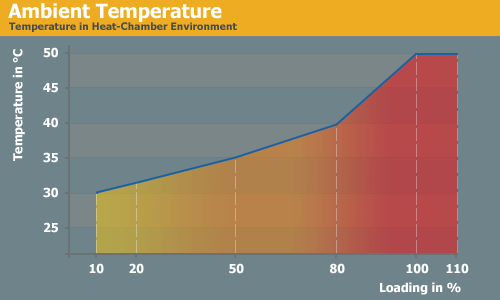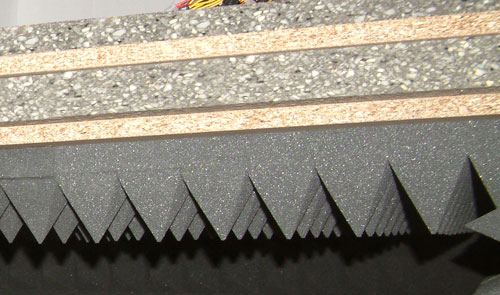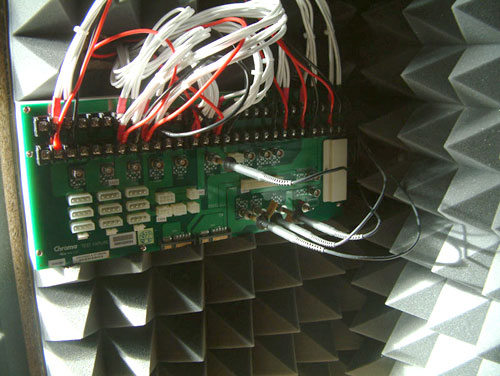Cooler Master UCP 900W
by Christoph Katzer on July 29, 2008 3:00 AM EST- Posted in
- Cases/Cooling/PSUs
Testing with the Chroma ATE Programmable Load

Our test equipment consists of two Chroma programmable DC Loads that enable us to test power supplies with an output of up to 1500W. The biggest advantage of the Chroma DC Loads is simply the high precision it provides. It can measure differences as small as 0.001V and 0.0001A, which will provide us with best-in-class results.
When programming the Chroma with specific amounts of load calculated according to the ATX norm, we are able to load power supplies to an exact percentage. We can now show results at every specific percentage needed. To get the best overview of a power supply, we load each unit with 10%, 20%, 50%, 80%, 100%, and 110% of the specified output. This is easy to calculate for a 1000W power supply: the 10% load is 100W and 110% load is 1100W. Remember that this is the amount of power the PSU delivers; due to inefficiencies, a power supply will actually draw more power from the wall.
Note: If you would like to know more about our testing methodology, equipment, and environment, please read our PSU testing overview.
We have added an additional 10% on the highest load to see how the units perform with overload. This test will be performed in all future reviews. The overload test is performed at room temperature as well as under more stressful conditions; to ensure we are not too cruel to the power supplies, we will keep the ambient temperature at 50°C in the stress test. Experience shows that many units can stand the overload at room temperature but will experience problems with higher temperature and overload together. Only the best-built units will survive this.

The Testing Environment
There is one flaw in testing power supplies with programmable loads while trying to measure the sound pressure levels at the same time. Because the programmable loads get very loud, there is no chance of hearing the power supply on the test stand. In order to make accurate measurements of the noise levels we needed a way to separate the test unit and the programmable loads. Our solution was to build a very thick box around the unit.

We concluded that a five-layer box with a total thickness of 6" (15cm) containing two layers of wood and three layers of special foam would suffice. It is designed as a box within a box. The inner box does not touch any part of the outer box, making it difficult for acoustic noise to pass through in the form of vibration. Each box is isolated on both sides with a layer of heavy foam that is normally used to insulate engines. On the inside we have an additional layer of 4" (10cm) thick pyramidal foam on every side of the box to eliminate the acoustic waves coming from the test object as well as we can.

To ensure a completely closed system we installed the printed circuit board that the connectors of the power supply are attached to inside the anechoic room/box. In other box designs, you would need to put all the cables through the wall. Unfortunately, that would result in the inside of the box not being fully isolated anymore. Our design keeps everything that needs to be connected inside of the box and maintains isolation.










33 Comments
View All Comments
andlcs - Wednesday, July 30, 2008 - link
Solid polymer capacitors are ELITE brand.http://www.chinsan.com/product/index.asp?id=22">http://www.chinsan.com/product/index.asp?id=22
sheh - Tuesday, July 29, 2008 - link
20% load efficiency at is lower than 85% regardless of input voltage.strikeback03 - Tuesday, July 29, 2008 - link
IIRC they test by the ATX methodology, not the 80Plus loading, which might account for the difference.MrOblivious - Tuesday, July 29, 2008 - link
Or it could be the unit to unit variation, the different temperature, or the different load pattern, etc. ;)JarredWalton - Tuesday, July 29, 2008 - link
Definitely true. The 80Plus loading methodology differs from the standard ATX loading, and that can easily account for the 1-2% difference between what Christoph measured and what CM reports.MrOblivious - Tuesday, July 29, 2008 - link
80Plus does list what the requirements for certification on each test report (115v 60hz) and the load steps used to accomplish them. You can see the UCP report here: http://www.80plus.org/manu/psu/psu_reports/SP215_C...">http://www.80plus.org/manu/psu/psu_repo..._MASTER_...They don't list the temperature there but IIRC it is 25c (will have to check when I get home). Also, 80 Plus Silver is 85-88-85% not 82-85-82% as it seems to be indicated.
tomoyo - Tuesday, July 29, 2008 - link
I was just about to mention this as there's some misinformation on 80plus scattered about in the article. Hopefully you'll clean that up soon. To me it's a pretty big achievement to get 85-88-85 at 25C on 115V on a huge 900w psu like this one. One thing I've noticed is that some of the new low power psu models are showing extremely high low wattage efficiency such as 90-92%. Some of these include the two dell 80plus silver models and some of the new actel ones. 80plus Bronze is much easier to achieve as most 80plus psu's are already near 85% in the middle range.JarredWalton - Tuesday, July 29, 2008 - link
"80Plus Bronze requires at least 82% efficiency at 20% load, 85% efficiency at 50% load, and 82% efficiency at 100% load. 80Plus Silver bumps the requirements up to 85%/88%/85% for the same 20%/50%/100% loads. In short, the Cooler Master 900W UCP had better be able to reach 88% efficiency."I'm not sure how that's at all confusing. As to the UCP 900W actually achieving Silver in our tests, it does appear to fall just short at the 20% load mark, but only by ~1% (84% efficiency when it's supposed to be 85%). I'm not going to worry overly much on that point, as there's a certain margin of error in testing.
MrOblivious - Tuesday, July 29, 2008 - link
"Before you get too carried away with the high efficiency, however, we need to rain on your parade a bit. The 80Plus Silver badge means that most users will get at least 82% efficiency, but even 20% load represents a power output of 180W, which for an idle system represents a significant amount of high-end hardware."Since that is NOT what 80Plus Silver means it could be a bit misleading.
JarredWalton - Tuesday, July 29, 2008 - link
Ah... I see my typo. I put that paragraph in, and apparently hit a 2 instead of 5. Should be 85% there, you're right....